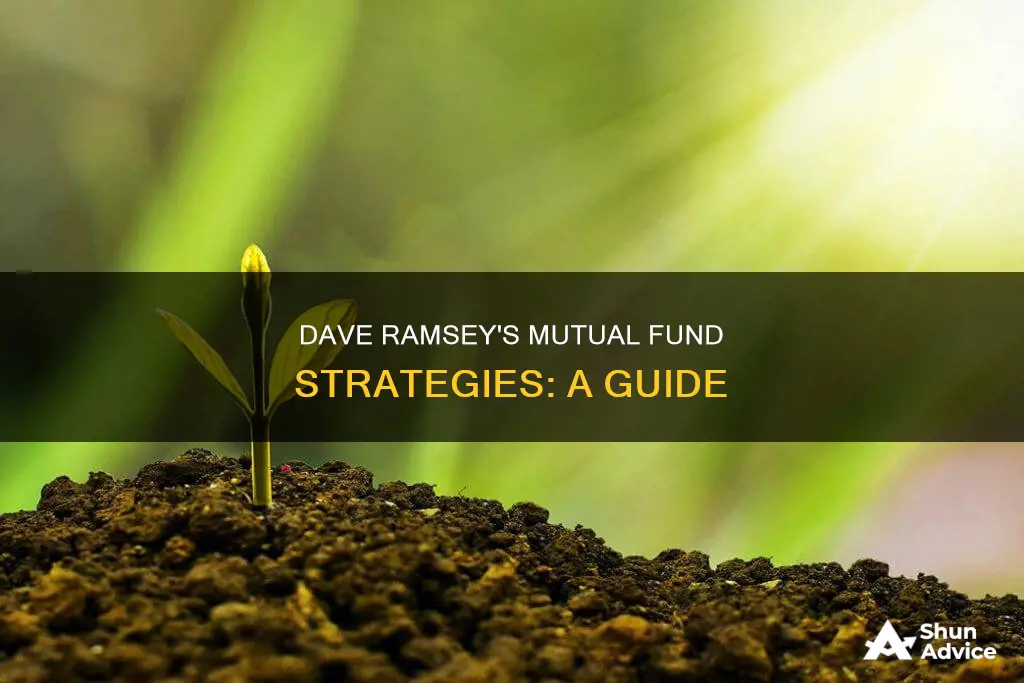
Dave Ramsey is an American financial advisor and radio show host who has authored several books on personal finance. He recommends investing in four types of mutual funds: growth and income, growth, aggressive growth, and international. He advises investing 25% in each of these four types of funds to diversify and reduce risk.
Ramsey suggests that investors seek out mutual funds with a long history (at least 10 years) of strong returns that consistently outperform the S&P 500. He also recommends focusing on growth stock mutual funds, which grow faster than the rest of the market, and cautions against investing in anything that is not understood.
| Characteristics | Values |
|---|---|
| Number of types of mutual funds to invest in | 4 |
| Types of mutual funds | Growth and Income, Growth, Aggressive Growth, International |
| Recommended annual return | 10% minimum, 12%+ is best |
| Understanding of investment | Don't invest in anything you don't understand |
| Diversification | Spread investments across different types of funds and companies |
| Management | Actively managed by a team of professional managers |
| Risk | Higher risk for higher returns |
What You'll Learn

Growth and income funds
Dave Ramsey advises investing in four types of mutual funds: growth, growth and income, aggressive growth, and international. He recommends investing in mutual funds with a 10-year or better average annual return of more than 10% (12%+ is best).
The goal of a growth and income fund is to create a diversified portfolio that takes advantage of the capital gains potential of the growth segment and the dividend income and stability of the value segment. These funds are popular among investors with a moderate appetite for risk, as they offer stability without sacrificing returns that outpace inflation.
When considering growth and income funds, investors should be aware that these funds come in many configurations, and it is important to research each fund strategy and use a style box for easier categorization. While returns may lag behind pure growth funds, there are times when high-yielding stocks become favoured in the stock market, leading to superior performance for growth and income funds.
The stability of these funds is particularly attractive when the broader economy appears to be weakening. As investors age and their risk tolerance changes, the percentage of equity exposure decreases, with financial professionals recommending that individuals subtract their age from 100 to determine the percentage of stocks they should hold, with the balance in less volatile bonds and cash.
For example, a 25-year-old investor entering the workforce would hold more stocks compared to a 70-year-old retiree. This is an important consideration when planning investment strategies, as the age of the investor directly impacts asset allocation and risk tolerance.
Liquid Fund Investment Strategies: Where to Invest?
You may want to see also

Growth funds
When investing in growth funds, it's important to look for funds with a history of strong returns or ROI. Focus on long-term returns—10 years or longer if possible. You want to choose funds that have consistently outperformed most funds in their category.
It's also crucial to pay attention to the fees associated with growth funds. The expense ratio, which covers the costs of managing the fund, should be less than 1% to be considered reasonable. Avoid funds with high turnover ratios, as this could indicate that the management team is trying to time the market for bigger returns or is not confident in their investment choices.
By investing in growth funds, you're betting on companies that are on an upward trajectory. These companies are typically more established and have a strong market presence. However, their stock prices can be more volatile and sensitive to economic changes.
To summarise, growth funds offer an opportunity to invest in medium to large American companies with strong growth potential. When selecting growth funds, consider their long-term performance, fees, and turnover ratios to make informed investment decisions.
Unit Trust Funds: Benefits of Investing
You may want to see also

Aggressive growth funds
Dave Ramsey advises investing in four types of mutual funds: growth, growth and income, aggressive growth, and international. He recommends investing in mutual funds with a 10-year or better average annual return of more than 10% (12%+ is best).
Some examples of aggressive growth funds include:
- The ClearBridge Aggressive Growth Fund (Ticker: SHRAX)
- Morgan Stanley Institutional Discovery MPEGX
- Vanguard Mid-Cap Growth VMGRX
- T. Rowe Price Mid-Cap Growth RPMGX
It is important for investors to closely examine the risk metrics of aggressive growth funds before investing. Beta, Sharpe Ratio, and standard deviation are three risk metrics that can help investors understand the fund's risks. The Russell 3000 Growth Index is a good benchmark for investors when considering aggressive growth funds.
Debt Funds in India: Worth the Investment Risk?
You may want to see also

International funds
When choosing international funds to invest in, it is important to look at the fund's long-term history and how it has performed over the last 10-20 years, rather than just the last year or two. It is also crucial to compare the fund's performance with other similar funds in the market and understand the fund's fees and expenses.
Why Tracker Funds are a Smart Investment Choice
You may want to see also

Stock funds
Of all the types of mutual funds, stock funds are usually the most volatile, but they also carry the greatest potential for growth and higher rates of return over time. This is because each mutual fund has a team of professional managers who pick and choose the stocks to include in these funds, with the goal of bringing in better returns than the market or other similar funds.
Dave Ramsey recommends focusing on growth stock mutual funds, which grow at a faster rate than the rest of the market. The average annual rate of return of the stock market is between 10-12%collectively beat the stock market over time.
Growth stock mutual funds are often categorized by their cap size, or how much the companies they invest in are worth. Here are the different types of growth stock mutual funds:
- Small-cap funds: These invest in companies valued below $2 billion. They are considered the riskiest but can offer the highest potential returns.
- Medium-cap funds: These invest in companies valued between $2-10 billion. They offer moderate growth and volatility.
- Large-cap funds: These invest in companies valued at more than $10 billion. They are the largest and most stable companies and are considered the calmest type of growth stock mutual fund.
To reduce investment risk, Ramsey recommends splitting your investments evenly (25% each) between four types of stock mutual funds: growth and income, growth, aggressive growth, and international. This ensures that you are not relying too heavily on one particular fund to perform well.
- Growth and Income Funds (Large Cap): These funds provide slow and steady growth by investing in large-cap companies that rise and fall more slowly than smaller companies.
- Growth Funds (Medium Cap): These funds invest in medium-cap companies, creating moderate growth and volatility.
- Aggressive Growth Funds (Small Cap): These funds are also known as emerging market funds or small-cap funds. They can make big gains and losses in a short amount of time and often invest in startups with high growth potential.
- International Funds: These funds help diversify your investments by investing in large companies outside of the US, such as BMW, Mercedes, and LG.
Funding vs Investment: What's the Difference?
You may want to see also
Frequently asked questions
Dave Ramsey recommends investing in four types of mutual funds: growth and income, growth, aggressive growth, and international.
Mutual funds allow you to invest in a lot of companies at once, from large, stable companies to newer, faster-growing ones. This helps to spread your investment risk.
Dave Ramsey suggests looking for mutual funds with a long track record (at least 10 years) of strong returns that consistently outperform the S&P 500.
Dave Ramsey recommends investing 15% of your household income in retirement accounts, such as a 401(k) or Roth IRA.
Mutual funds carry risks, including volatility and the potential for losses. Additionally, some mutual funds may have high fees and costs associated with them.







